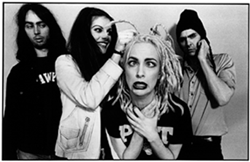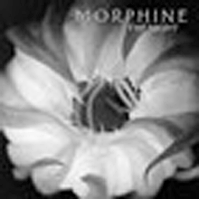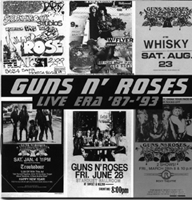


Boss Hog
Whiteout
The story of Boss Hog's conception reads like a rock and roll soap opera. With Christina Martinez as the sultry heroine in spike-heeled boots, and Jon Spencer, whose brand of distorted, fire-eating rock and roll has single-handedly given rise to countless garage oriented rip-off artists, Boss Hog is nothing if not bad ass.
The first act started on the streets of D.C., when the two met at a Jesus and Mary Chain concert. Christina had been living there; Jon had just dropped out of Brown to start his path to stardom with the devastatingly raucous noise/punk band, Pussy Galore. The story couldn't be much simpler than a rock and roll version of the boy meets girl standard.
Christina Martinez started in the rock and roll business by taking photos for the first Pussy Galore 7 inch, but eventually she would wind up doing much more for them than just taking photos, eventually dropping school to fill in as third guitarist, and giving Pussy Galore a visual shot in the arm by appearing in some eye catching and controversial cover art. Time would prove that Christina Martinez was no third guitarist for anyone, and when things with Pussy Galore eventually got rocky Boss Hog was born with Martinez in the spotlight.
In 11 years Boss Hog would eventually grow from Amphetamine Reptile Records to sign a five-record deal on DGC/Geffen. But no soap opera is complete without a few disasters, and Boss Hog didn't make the cut when Geffen merged with Interscope and A&M.
Making the most of the break, Boss Hog returns with Whiteout on California- based indie-label, In the Red. But it isn't just the label that has changed. Whiteout brings not only a shift in personnel, but also a dramatic shift in a more groove-oriented direction.
With the addition of Mark Boyce on keyboards the orientation of the band is fully different, sounding more at times like New York City ever-present girlie act Luscious Jackson than a traceable product of their own punk history. Ultimately Boyce's Stax-ish organ and keyboard contribution and the use of much more electronic beats and mature production, Whiteout ventures far from the in-your-face attitude that stayed with early Boss Hog from the Pussy Galore days.
But in many ways lovers of Boss Hog will probably have enough to hang on to in Whiteout to be satisfied. So now Martinez sings in a sexy way instead of screaming in a sexy way, and Jon Spencer continues to be the meanest kid on the rock and roll block. The elements of the good old days are still somewhat audible. If Whiteout shows anything, it's that the long story of Boss Hog is far from finished.
-Nate Cavalieri

Morphine
The Night
Before Morphine frontman Mark Sandman suffered a fatal heart attack during a performance in Italy last July, his band had been working feverishly from the confines of their Cambridge, MA studios to complete the long-awaited follow-up to Like Swimming, their 1997 masterpiece of low-end rock and smooth, sensual jazz. Though Sandman's untimely passing prevented the trio from putting the proper finishing touches on that work-in-progress, surviving members Dana Colley and Billy Conway dutifully carried on without their principal singer and songwriter, redoubling their efforts to produce The Night, the band's fifth and final release. The album is a fitting tribute to the rich musical legacy left behind by Sandman, and it is easily Morphine's most ambitious work. As their swan song, it is as satisfying as it is bittersweet, hinting at the bold new direction that the trio might have taken were it not for the tragic death of their leader.
The Night begins promisingly enough with the title track, a slow, seductive number that finds Sandman's pleading vocals drowning into a luscious sea of bass, baritone saxophones and cellos. Like the equally impressive "Souvenir," it is vintage Morphine, as irresistible and sexually-charged as Cure for Pain's "Let's Take a Trip Together" and Yes's "I Had My Chance." The band turns it up a notch for "A Good Woman is Hard to Find," a bluesy shuffle in the tradition of "Thursday" that showcases Sandman's pounding bass riffs and Conway's versatility as a jazz percussionist. And though their decision to add background vocalists Linda Viens, Carolyn Kaylor and Ramona Clifton to the mix on the rollicking "Top Floor, Bottom Buzzer" falls flat, the trio saves the best for last, closing The Night with the epic "Take Me With You." With its haunting orchestral arrangements and its desperate lyrics ("Take me with you when you go/Don't leave me alone/I can't live without you"), "Take Me" is easily the finest track on the album, a majestic accomplishment that will ultimately rank with Morphine's best.
While The Night is not the band's most impressive work - that honor will always belong to 1993's Cure for Pain - it is consistently strong, a testament to Sandman's ingenuity as a composer, a lyricist and a visionary. Sadly, his death has deprived fans of the pleasure of listening to his evolution as a musician, but he is survived by a body of work that distinguishes Morphine as one of the freshest, most exciting American bands of the past decade.
- Rossiter Drake

Guns N' Roses
Live Era:'87-'93
Seven years ago, Guns N' Roses bid an unemotional farewell to their fans, leaving in their wake a trail of chaos, controversy and confusion, not to mention The Spaghetti Incident?, a wan collection of punk rock covers that quickly found its way to the clearance bins in record stores across the country. To be sure, the band that resurrected rock n' roll for a new generation of angst-ridden teenagers with the 1987 release of their astonishing full-length debut, Appetite for Destruction, was dead, slain by a lethal combination of drugs, oversized egos and internal feuding. Now, as GN'R prepares to blast its way back to the top of the charts with a revamped lineup that features only one original member - mercurial lead singer Axl Rose - the quintet that was once known as the most dangerous band on the planet has temporarily returned with Live Era: '87-'93, a career retrospective culled from their legendary live shows.
Wisely, Live Era draws heavily from Appetite, featuring strong renditions of that album's most popular entries ("Welcome to the Jungle," "Paradise City") and lesser-known gems ("Rocket Queen," "It's So Easy"). After an introduction that pays subtle homage to the hard-rock forefathers of KISS, the band launches into a ferocious version of "Nightrain," their classic ode to hard alcohol and hard living. They follow that opener with two solid hours of maximum rock n' roll, serving up a few pleasant surprises ("Pretty Tied Up," an overlooked jewel from Use Your Illusion II, and a rare performance of "Used to Love Her") and a couple of the necessary duds ("November Rain," "Dust N' Bones"). Even when the band falls flat on its face, however, Axl, Slash and company quickly pick themselves up with some profane stage banter and a soaring guitar solo.
As one might expect from any Guns N' Roses release, the record offers plenty of thrills and guilty pleasures, from a rollicking version of "Mr. Brownstone" to a delightfully melodramatic reading of "Estranged." But Live Era ultimately fails to capture the aura of excitement, danger and unpredictability that accompanied a typical GN'R show. Worse yet, much of the material culled from the band's Use Your Illusion stadium tour lacks the passion and intensity that was palpable during their early club shows. For proof, just compare the Illusion-era tracks on Live Era to the blistering performances of "Nice Boys" and "Reckless Life" immortalized on GN'R Lies. The first four tracks on Lies (originally released in 1986 on the appropriately-titled E.P. Live?!#@ Like a Suicide) captured the sound of an angry band that was starved for a taste of success; Live Era finds that same band wallowing in the wretched excesses of fame and fortune, losing touch with the raw aggression that once made their music so powerful.
Thus, it seems that the boys from GN'R indulged the perils of rock n' roll decadence a bit too eagerly, succumbing to the same complacency that once transformed Elvis into a bloated lounge act and the lean, mean Eddie Murphy of Beverly Hills Cop into the out-of-touch superstar who snoozed his way through Another 48 Hrs. As the final chapter in the legacy of a great band that chose to crash and burn rather than fade away into obscurity, it is a valuable asset to any collection, and it shows that the GN'R catalogue has lost little of its edge over the years. But Live Era also paints the portrait of a band sinking under the weight of its own stardom. It is an accurate portrait, but not always a pretty one.
- Rossiter Drake
Copyright © 2000, The Oberlin Review.
Volume 128, Number 14, February 18, 2000
Contact us with your comments and suggestions.